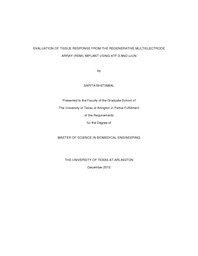
ATTENTION: The works hosted here are being migrated to a new repository that will consolidate resources, improve discoverability, and better show UTA's research impact on the global community. We will update authors as the migration progresses. Please see MavMatrix for more information.
Show simple item record
| dc.contributor.author | Bhetawal, Sarita | en_US |
| dc.date.accessioned | 2014-03-10T21:17:27Z | |
| dc.date.available | 2014-03-10T21:17:27Z | |
| dc.date.issued | 2014-03-10 | |
| dc.date.submitted | January 2012 | en_US |
| dc.identifier.other | DISS-12032 | en_US |
| dc.identifier.uri | http://hdl.handle.net/10106/24045 | |
| dc.description.abstract | Currently available peripheral nerve regenerative interfaces such as the sieve and the micro-channel regenerative electrode, intended to be used for the control and natural feel from advanced robotic prosthetic devices, eventually fail due to nerve damage due to axonopathy. The Regenerative Multi-electrode array (REMI) developed in our lab overcomes this limitation by providing a non-obstructive pathway for regenerating axons. However, it is possible that the mismatch at the electrode-tissue interface may cause axonal injury during limb stretching. In order to determine if micro-motion at the REMI causes neuronal injury I evaluated the nuclear expression of Activating Transcription Factor 3 (ATF-3), and cJUN in the sensory dorsal root ganglia neurons, in animals that received either normal (70%) or excessive (100%) limb stretching. I hypothesized that persistent expression of ATF-3 would indicate continued micro-injuries caused by mechanical mismatch at the REMI electrode-nerve interface, and that cJun expression will decrease overtime, unless axonal regeneration is elicited by limb stretching. Sixteen adult rats received a REMI implant in the sciatic nerve and underwent weekly cyclical limb at 70% and 100% stretching (n=8 per group), and evaluated at 30 and 60 days. Quantitative analysis revealed that the percentage of ATF-3 expression decreased from 30 to 60 days in both 70% and 100% stretching groups, similarly to control animals, suggesting that REMI implantation does not cause micro-motion induced axonal injury. Conversely, the regenerative marker c-Jun showed an initial increment in expression, which was maintained for 60 days in the 70% stretch group, but reduced significantly at 60 days after 100% stretching. This unexpected finding may be explained by known beneficial effect of exercise in nerve regeneration. To determine if such repose differs in the sub chronically injured nerves, c-Jun and ATF-3 expression was quantified in animals 30 days after nerve amputation. ATF-3 expression in this model showed a significant decrease from 15 to 60 days, comparable animals with acute REMI implantations. Together, the present results suggest that REMI implants do not induce tissue micro-injury and form a stable interface, supporting the notion that such interface might be reliably used to successfully interface the peripheral nerves with the intention to naturally control a robotic prosthetic device. | en_US |
| dc.description.sponsorship | Romero-Ortega, Mario | en_US |
| dc.language.iso | en | en_US |
| dc.publisher | Biomedical Engineering | en_US |
| dc.title | Evaluation Of Tissue Response From The Regenerative Multielectrode Array (REMI) Implant Using ATF-3 And cJun | en_US |
| dc.type | M.Engr. | en_US |
| dc.contributor.committeeChair | Romero-Ortega, Mario | en_US |
| dc.degree.department | Biomedical Engineering | en_US |
| dc.degree.discipline | Biomedical Engineering | en_US |
| dc.degree.grantor | University of Texas at Arlington | en_US |
| dc.degree.level | masters | en_US |
| dc.degree.name | M.Engr. | en_US |
Files in this item
- Name:
- Bhetawal_uta_2502M_12032.pdf
- Size:
- 2.903Mb
- Format:
- PDF
This item appears in the following Collection(s)
Show simple item record


